We are building a fleet. Wrong ideas, wrong concepts
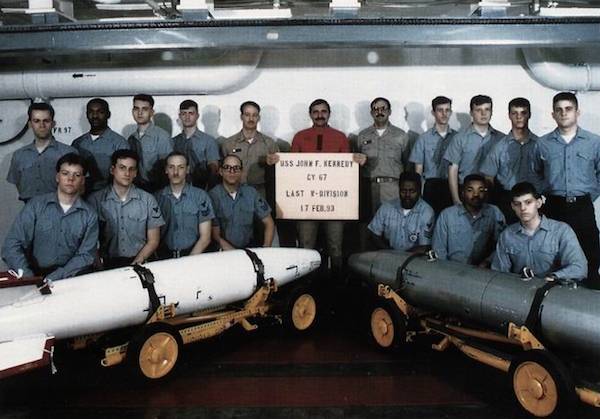
1. Nuclear weapons as insurance against attacks and the “equalizer of chances”
It has been present in the domestic military theory for a long time, and even now the theory of the so-called nuclear de-escalation is mentioned. In short, its meaning is that, if it is impossible to get out of a non-nuclear war without defeat, Russia may resort to a one-time limited use of nuclear weaponsto "besiege" the attacker and persuade him to end the hostilities. Domestic military experts considered various options for such an application - from striking empty areas at sea for demonstration purposes, to a limited nuclear strike against non-nuclear allies of a nuclear aggressor.
In relation to a war at sea, one of the possible varieties of such actions is the delivery of limited nuclear strikes against naval groups of the enemy.
However, the following must be understood. The use of nuclear weapons entails a lot of negative consequences even without taking into account the enemy’s retaliatory moves. Among them:
a) undermining the reputation of the attacker and his political positions in the world, and undermining a very serious one, comparable in consequences to a lost war;
b) the need to escalate is even higher if the adversary against whom nuclear weapons are used does not surrender. Escalation will be impossible without destroying the enemy’s civilian population, and in this case, unrequited. Subsequently, a serious moral crisis in society in the future is possible up to the appearance of a “guilty complex” similar to that which some Europeans experience in relation to representatives of peoples once colonized by Europeans;
at) an adversary struck by a nuclear strike may consider himself entitled to resort to such methods of warfare that he would not have resorted to otherwise. For example, the use of combat strains in the territory of an attacker, or the large-scale equipping of terrorist groups with such weapons as MANPADS; significant sponsorship, support and use of terrorism, various forms of attacks on nuclear facilities, and so on. You need to understand the important thing: other cultures have their own ideas about the permissible and unacceptable, and they do not coincide with ours. The concepts of unacceptable and acceptable damage also differ. Other people think differently from us. It seems to them logical and self-evident is not the same as to us and not the same as to us.
All of the above is true for a nuclear strike on a non-nuclear country. If the attacked enemy also has nuclear weapons, then the situation changes radically. Having suffered losses from nuclear weapons, the adversary may well have resorted to a retaliatory nuclear strike. Moreover, for many domestic theorists it is not obvious - not necessarily a “symmetrical" blow.
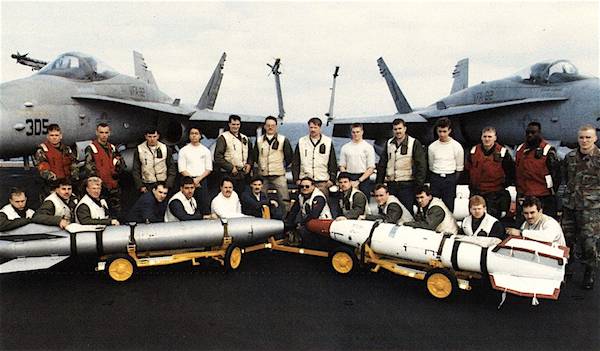
The US Maritime Strategy in the 80's stated verbatim that in response to the use of nuclear weapons by the USSR against US forces at sea, a retaliatory US nuclear strike would not necessarily be limited to the sea. Thus, the Americans, after the first use of nuclear weapons against their ships, quite seriously considered themselves entitled to retaliate against nuclear weapons on Soviet territory.
Now the situation has not changed. American guidance documents indicate that the ideas of Russian theorists about the "stopping" effect of the use of nuclear weapons are wrong. The generally accepted opinion is that in response to the limited use of nuclear weapons against the United States or its allies, the United States must use its nuclear weapons against the Russian Federation, and, unlike us, the Americans do not see the difference between hitting ships where there is only military personnel, and a blow to ground objects, where there are civilians. For them it is the same.
Thus, the likelihood of a retaliatory nuclear strike against attempts at "nuclear de-escalation" against the Navy of a nuclear country with the highest (in the case of the USA, with an 100%) probability will lead to a retaliatory nuclear strike, moreover, on the territory of the Russian Federation, with high accompanying losses among the civilian population .
Does this mean that nuclear weapons are not applicable specifically as weapons, and not as a means of deterrence? No, that doesn’t mean, but you need to be aware of the price of its use and be prepared to pay it. The use of nuclear weapons against a non-nuclear adversary, instead of surrendering it, can cause an asymmetric escalation of the conflict with the simultaneous bringing of the Russian Federation to the need to use nuclear weapons already on the territory of the enemy, destroying, including its population. Such a victory may be worse than defeat.
In the case of a strike against an adversary with a nuclear weapon, there will be absolutely no de-escalation, but there will be a nuclear war, possibly limited at first, which will have to be fought, with all the ensuing consequences and risks.
It should also be understood that nuclear weapons alone do not stop both nuclear and non-nuclear countries from attacking. In 1950, non-nuclear China attacked UN troops (count the United States and its allies) in Korea; American nuclear weapons did not deter it. In 1969, the nuclear year already at that time, China attacked the nuclear USSR at the border, and more than once. In 1982, non-nuclear Argentina attacked nuclear Great Britain and seized its overseas possession - the Falkland Islands. In 2008, non-nuclear Georgia attacked Russian troops in South Ossetia. The presence of nuclear weapons in Russia did not become a deterrent.
Scaring the enemy with nuclear bombs may not work. You need to consider this in your planning.
2. "Small" fleet without a "large"
Theory of "Small fleet"Exists for more than a hundred years and its meaning boils down to the following: it is theoretically possible to create such ships that, being small and inexpensive, can nevertheless easily destroy large and powerful enemy ships, or wage war on their communications due to superiority in weapons or stealth. Initially, such destroyers were torpedo boats, then torpedo boats and submarines, then they were also missile boats or various types of small missile corvettes (like Soviet or Russian RTOs, for example).
This theory has never been fully confirmed in practice, but it has failed many times. There are some successful episodes of the use of small ships armed with torpedoes in the 19th century, when they caused significant damage to large warships, as well as examples from the 20th century - the destruction of the Israeli Navy destroyer Eilat by Arab missile boats in 1967 and the successful use of Indian missile boats against Pakistan in 1971 year.
All these small piece examples are united by one thing - they took place when the weapons on the small ship and the large ship struck by it belonged technologically to different eras. In the future, the “balance” was leveled and after that the small ships lost all chances to cause large ships any damage, acting independently. This was the case, for example, during the operations of the Iranian Navy and Air Force against the Iraqi fleet, this was the case in the operations of the US Navy against the Libyan Navy in 1986 and against the Iranian Navy in 1988 (see the article “The harmful myth of the mosquito fleet”). "Small fleets" were destroyed at best within hours, but sometimes within minutes.
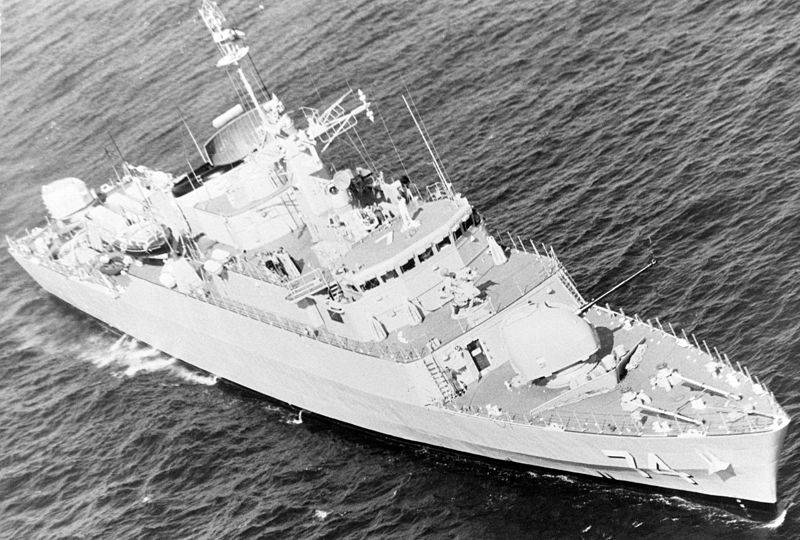
It was also easy and lossless that the entire Iraqi fleet was destroyed by the Allies in the 1991 year, and the US superiority in the air here was of indirect importance, since the substantial and most combat-ready part of Iraq’s warships was destroyed with a handful of British helicopters launched from full-fledged warships (see article "Air fighters over the ocean waves. On the role of helicopters in the war at sea") The large fleet beat the small one, as it had repeatedly before.
A small fleet operating independently ALWAYS turned out to be helpless against a normal fleet, and its fate was always very sad.
Does this mean that “light” forces at sea are not needed at all and never? No, it doesn’t, but it’s a “niche” tool. Worth remembering:
Light forces can successfully carry out their combat missions only when they are supported by "heavy" and ensure their combat stability.
Examples: Togo destroyers, with which the latter attacked the Russian fleet. They did not act on their own. American submarines in the Pacific War, the success of which was ensured by surface forces of the US Navy, chained to themselves everything that the imperial fleet of Japan had and did not allow to allocate any resources for the creation of anti-submarine forces.
Counterexamples, too, are not few - Soviet and American torpedo boats of World War II, which did not sink almost anything, both lost German submarine wars. Independently operating "light" forces, even though submarine, even surface, though they could inflict some losses on the enemy, in the case of German submarines - big losses, but in general they could never influence the course of the war.
In general, before the “young school” distorted the development of the Soviet fleet in the 30's, this understanding was present in our fleet. So, in the thirties, the battleship in the Soviet navy was seen as a means of giving combat stability to light forces. Similar provisions were in Soviet regulations after the war, and light cruisers of the 68bis project even provided facilities and communications for the command post of torpedo boats.
Moreover, the thesis that the main purpose of the existence of a linear fleet is to ensure the actions of cruisers and light forces was expressed by Julian Corbett in his famous book.
Such use of light forces can be quite effective. So, an MRC attacking an enemy convoy is powerless and against aviation, and against submarines, but if he attacks from an order as part of one or several BODs and a cruiser, then his combat stability and ability to fight become completely different.
Or another example: small anti-submarine ships may well displace an enemy atomic submarine from a given area, and simply destroy an atomic submarine (and they could get an atomic one in theory if they were lucky), but against a massive strike from CPUG carrier-based aircraft from four to five such ships look very pale (let’s leave the question of successful evasion of the CPG from the strike “outside the brackets”).
But everything changes if the ship search and strike group (KPUG) consisting of them relies on a pair of frigates with powerful air defense systems - then the success of the air raid becomes a question, and in any case, the planes cannot completely destroy the ship group, although the losses remain quite probable. The effectiveness of the anti-submarine actions of the KPUG also increases significantly, firstly because frigates have anti-submarine helicopters, and secondly because they have powerful sonar systems (in theory, at least, they should be).
From this, the truth follows a consequence that lovers of small ships will not like - large ships can replace them if their number allows them to carry out a combat mission. Or, figuratively speaking, a fleet of "light" and "heavy" forces can fight very well, a fleet of only "heavy" forces can also fight, but it is not always optimal and has a smaller strength, and a fleet of only "light" forces really can’t. The "small" fleet, separately from the "large" fleet, is useless and no matter how much money is lacking, it is impossible to slip from the economy to the construction of only small ships. Or they can perform well only one combat mission, for example, cover submarines leaving the bases (in the case of the IPC), and that’s all. But so wars are not won. All of the above does not eliminate the need to work on such small ships as an anti-submarine corvette or a minesweeper-seeker.
3. "Umbrella air defense"
There is an opinion, and many military professionals adhere to it, that it is possible, relying on coastal airfields, to create such an air defense system of the coastal zone in which ships could operate, being relatively safe from enemy air attack means. Naturally, such a zone seems to be coastal, “under the coast”.
It’s worth noting right away: Russian military science sees this defense system exclusively as a combination of radar surveillance equipment (preferably AWACS) and fighter aircraft. This is understandable and natural, because ground-based air defense systems will not have enough range, even if you put them on the edge of the water (which in itself will never happen).
What is the depth of such “aircraft” air defense from the point of view of domestic theorists?
As far back as 1948, during the work to determine the shape of future Soviet aircraft carriers (these ships were not destined to appear), a commission led by Rear Admiral V.F. Chernyshova determined that without protection from carrier-based fighter aircraft, surface warships will be able to operate no further than 300 kilometers from the coast. This was not true for all possible situations, but for a situation where the enemy is standing at the gates and has carrier-based aviation - more or less correct.
Then the commission operated on the fresh experience of World War II, mainly the American one, and on the tactical and technical characteristics of airplanes and aviation weapons of that time.
At the end of the 80's, the numbers were already voiced different. So, in the 1992 year in the “Marine Collection” an article was published by the rear-admiral F. Matveychuk, the retired vice-admiral V. Babi and the captain of the 1 rank V. Potvorov “Aircraft-carrying vehicles - an element of a balanced fleet”, where Air defense capabilities built around coast-based fighters were characterized as follows:
Remember these numbers. If we have a detection range of attacking aircraft in 550-700 kilometers, then 150-250 km will be the distance from the base airfield, on which aviation can protect ships from air strikes.
It’s worth roughly counting. The 2 airborne regiment is ready (pilots in the barracks, planes are ready for immediate take-off, the command and control station is ready to start take-off operations immediately), when taking off, one plane should completely fly into the air, be in combat formation and go on the right course more than an hour from the receipt of the order. In case of take-off aircraft in pairs - in the area of 40 minutes. Then you need to go to the point where you want to intercept the enemy. Since aviation must thwart an attack on surface ships, it is necessary to prevent the enemy from reaching the line of launch of his missiles.
Suppose that there is a case where the airfield, the guarded naval group, and the adversary are on the same line. According to experience, the Americans (let’s take them as a “model” enemy) use the Harpoon anti-ship missiles not at their maximum range, but from about 30-40 kilometers, so if they are intercepted at 60 kilometers from the target, then the attack can be considered frustrated. and the task of the fighters completed. Let’s take into account that the launch range of air-to-air missiles, which ensures reliable destruction of targets covered by interference and evading targets, is, for example, 50 kilometers, which ultimately requires them to be in 160-260 kilometers from the airfield.
If we assume an extension at a speed of 1000 km / h, then in the fighter you need will be about 9 — 16 minutes. Together with 40 minutes for an alarm, collecting in the air and entering the course - 49-56 minutes.
How much will the enemy fly over that time, which was discovered at 700 kilometers from the ship’s group? The enemy is hung up with offensive weapons (RCC) and overhead fuel tanks, so his speed is lower, for example, let 740 km / h. Then he will fly the designated 700 kilometers in almost the same time - 57 minutes. And if he can give 800 km / h? Then for 53. But even the MiG-21 could fly near the ground at a speed of 930 km / h with full load in the shock version, and the Su-17 generally came out on the ground to supersonic with six units of ASP on the suspension nodes.
And if the radar field has a depth of 600 kilometers?
And the most important question: what if it's not an ocean theater? If we are not talking about a strike from the US carrier-based aircraft from somewhere hiding from an aircraft carrier hiding in the far sea zone, but about a strike by Polish fighter-bombers in the Baltic? Take-off from Szczecin, leaving northwest of Bornholm, turning around the island as a cover, jerking east, attacking targets near the Kaliningrad enclave, at sea, and leaving home west - this is quite real. And then the distance at which even the AWACS aircraft can accurately identify the “contact” as a threat is less than 500 kilometers.
Anyone can play with numbers. Increase the speed with which fighters advance to defend the ships, increase or decrease the speed with which the attacker goes on the attack, realistically change the detection range of the attacker ... the conclusion will be clear - very often, or even always, fighters from the shore will be late to repulse the blow even by a short distance . Even when the ships are almost under the coast - in 100-150 kilometers.
You can, of course, not wait for the entire air regiment to take off, but throw squadrons from different aerodromes into battle - if you can synchronize their arrival at the battlefield, but remember that the enemy, who owns the initiative, will not enter anything into the battle by squadrons, he will lift a large air group to provide both a powerful blow and a strong escort. And the introduction of fighters into battle along squadrons will simply lead to their execution in the sky by a numerically superior enemy.
You can send fighters into a counterattack at supersonic sound, and try to be at the right line of missile launch faster than the enemy, but this method has a lot of limitations - you need to have enough fuel for air combat and return later, including possible separation from the enemy also in supersonic band there should be no buildings or people flying over the earth, a group supersonic flight is more complicated than a single flight and pilots should be ready for this, including beginners, and so on - in general, this is not always possible. More often than not. But the attacker over the sea has basically no these problems (minus the ability of pilots to fly like that).
No "air defense umbrella" (forgive me people in uniform for such a "term") does not exist in principle. Even near the coast. Fighters can sometimes protect ships, and sometimes not, and this cannot be changed in any way. During the Falkland War, the British Harriers were late to repel an attack on surface ships, barraging in the air ten kilometers from them and receiving an alert about the attack and information about the location, course and speed of the enemy. In advance.
During the Cold War, the Americans, when planning air defense of carrier groups and formations, proceeded from the fact that interceptors on duty in the air would be able to disorganize the enemy’s attack, shoot down some (not large) part of his planes, “break” his battle formation and, as a result, to increase the scope of the missile salvo, after which the enemy would continue their attack and the URO ships would be sorted out with him and his missiles, and the interceptors urgently raised at the time of the attack would catch up with the Tupolevs who had survived the missiles fire naval air defense system.
"Air defense umbrella" does not exist, attackers are usually faster. This is how this world really works.
Which of these should be concluded?
The conclusion is simple: ships must be able to fight against airplanes themselves. That's all. The key to the successful survival of surface ships in the fight against aviation is competent tactics - the commander of the ship’s group must know the tactics of strike aircraft, understand the limitations that it has, be able to mislead the enemy’s reconnaissance regarding the strength, course and composition of forces entrusted to it, conduct ships in this way, so that an accurate and timely determination of their location by the enemy would not be possible, fight air reconnaissance, be able to organize the battle of ships against strike aircraft and control it process, to be able to fulfill the gap between tracking, timely withdraw ships from the zone of potentially possible air strikes, use decoys, creating a false warrant, and to entice him enemy aircraft, to organize a "missile ambush."
It is difficult, but it is not impossible.
The command of the fleet’s forces in the theater of operations, in turn, must conduct intensive misinformation of the enemy, provide subordinate units, formations and ships with all the necessary reconnaissance information, ensure that fighter aircraft are used in the interests of naval groups, and not so much from the “readiness number 2” at the airfield as from standby positions in the air. This means that there will be few interceptors, but at least they will be on time. DRLO aircraft are urgently needed.
The ships themselves must either have powerful radar systems and air defense systems. If, for economic reasons, it is impossible to build ships with powerful air defense (for example, this is a massive small corvette), then they must carry out their combat missions together with “normal warships. There will be no one else to defend them.
In any case, there will be no other way out. Or so, or nothing.
4. Navy on the defensive
The mentality of the Russian people, like most of the peoples living in Russia, is defensive. We are ready to open the trench and hold it until death, without retreating under any circumstances. Unfortunately, this mental feature does not work at sea as it does on land. The “principle of the shark” works at sea - to drive at maximum speed and grab everyone’s teeth in a row, tearing piece by piece. Run away, if necessary, and then come back again and attack, attack, attack. You still can’t dig a trench in the sea, the water is flowing.
Alas, not all of us are psychologically capable of taking such an approach, and historically, this was a problem for the fleet as well. We lack the aggression inherent in the same Americans, and together with the “defense” consciousness this gives rise to a specific approach to war at sea, and, alas, it does not work.
During the Crimean War, the command of the Black Sea Fleet did not think of a better use of ships than to flood them and use them as an obstacle for enemy ships, and send the crews to the infantry. I must say that wars are not won that way in principle, they are only lost. There is a ship - attack it on the enemy, there are no other options.
During the Russo-Japanese War, the 1 Pacific Squadron made just a few weak attempts to inflict serious losses on the Japanese, of which the 1 mining of May (14 in modern style) of the 1904 of the year, carried out by the Amur mine transport, was successful the next day. led to the death of two Japanese battleships. Two more such successes would lead to the defeat of Japan in the war. But they were not, and they were not because none of the Port Arthur squadron tried to aggressively "get" the enemy. “Cupid,” by the way, was hiding in the fog during mining, and had a range sufficient to break into Vladivostok, and it could go a significant part of the way at a good speed. But the ship returned to the fortress, had no more active use and died along with the entire Port Arthur squadron.
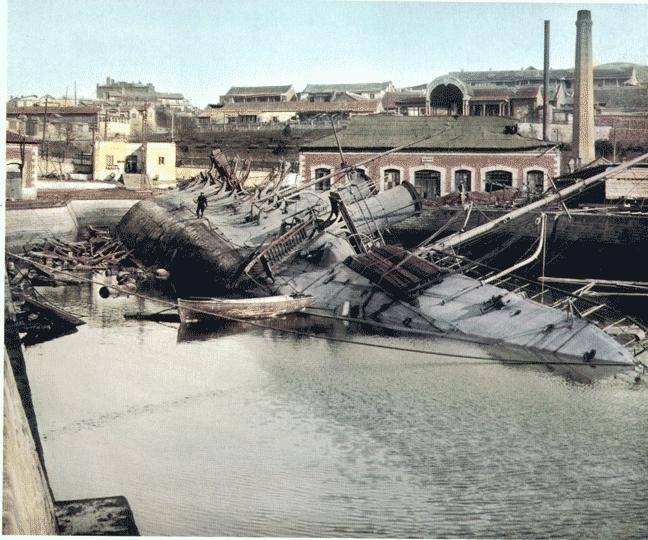
Analyzing the actions of the 1-th Pacific Squadron of the Russian Imperial Fleet, Mahan saw in them the whole concept of a "serf fleet", that is, a fleet holding an important fortress together with the army, and violently criticized it. Interestingly, he called the idea of a “serf fleet” with the words “definitely Russian”, which well reflects his view of the actions of our sailors and our mentality. Certainly, the Russian idea of a fleet passively defending itself in a fortress was never fixed in any documents, moreover, if it was formalized, there was hardly anyone in the fleet who could sincerely support it, but in fact the fleet was slipping into this very mode of action , and more than once.
This should not be allowed more.
In the naval guidance documents there are requirements to keep the initiative, attack the enemy and the like, but you must always remember that in addition to the instructions and charters, we still have a national mentality and, speaking of the current moment, there is also an army command to which the fleet is subordinate and which “ sees the world in his own way. " As a result, the bet on "defense of its shores" in the event of a real military conflict may again prevail, with the result already achieved more than once - defeat.
It must be clearly understood that the fleet cannot defend itself, it can only attack. And in conditions of numerical superiority of the enemy, too. Special operations such as defensive mining are exceptions and very “weak”. It is offensive actions, and not “reactive” ones, which are a reaction to the enemy’s activity, but independent ones, which are the key to the successful use of the fleet. They can be direct when battle is imposed on enemy ships, or they can be indirect when raids are carried out against its weakly protected bases and ships of the rear, but this should be offensive.
If the fleet’s base is blocked, as Port Arthur used to be, the answer is ONLY a breakthrough and withdrawal of warships from it, which then, as soon as possible, should be thrown into the offensive against the enemy’s fleet. The fleet cannot “defend its positions,” cannot and should not be in the attacked bases along with units of ground and coastal troops.
The ban on passive "defensive" actions of surface and submarine forces should be explicitly written down in all the governing documents, manuals and the like, despite the separate requirements for "maintaining a favorable operational regime" and establishing sea supremacy in a particular area.
5. Neutrals
Among military theorists and practitioners, there is a certain underestimation of the importance of actions to prevent harm to third parties not participating in the conflict. It is believed that the war will begin and nobody will pay attention to such “trifles”, and civil shipping and fishing will quickly disappear.
Let's figure it out.
A distinctive feature of the anti-ship missile is the primitive algorithm of its GOS. A missile can “take” its GOS or the first target that hit the detection sector, or choose from several the target with the largest EPR, depending on the algorithm. More complex principles of target selection, data exchange in a group of missiles and other innovations in the Navy were, but in the end did not take root, although something even stood in service. So everything remains simple.
But what will happen if a cruise liner escapes from the area of the outbreak of hostilities in a panic on the path of a missile launched at its maximum range, the crew of which, trying to hide, turned off even the navigation radars in fear? Could this be?
Of course, a cruise ship is a form of dramatization of the issue, although it may be. A runaway bulk carrier or a runaway tanker is more likely to be in its place. And that is the problem.
Non-military shipping and fishing did not disappear in the First or Second World Wars. For many societies, this is a matter of survival and people from these societies will go to sea in absolutely any situation.
At present, when assessing the effectiveness of fleet offensive weapons and tactics, the possibility of collateral damage is not taken into account - damage that was not planned and is not desirable. There is nothing new in causing collateral damage during hostilities, but the war at sea as usual has its own specifics - at sea, collateral damage can very easily be done to neutral countries.
This is especially easy with the massive use of anti-ship missiles in areas of heavy shipping or fishing.
RCC can be eliminated by passive interference. In this case, it will go away from the ship to the LOC - a false cloud of targets, and since the cloud is easily permeable, it will slip through it. Further, its lost target, the seeker, will again begin to look for something radio-contrast. It could very well be a neutral ship.
RCC can simply by inertia "slip" a ship with a low silhouette. So the Americans “missed” by shooting at a damaged Iranian corvette during Operation Mantis. And then she will again begin to search for the goal. And again, it could be a neutral ship.
The Gulf Americans realized this very well. The Praying Mantis was the last operation where American ships operating in the Persian Gulf in conditions of intensive shipping used the Harpoon anti-ship missile. According to the analysis of the course of the operation, especially the understanding of how many false “contacts” there were, fire on which would lead to defeat of friendly or neutral targets, the Americans established the requirement to identify the target visually (!) Before using weapons against it. Otherwise, you could mistakenly send a missile, for example, to a Soviet destroyer. With all that it implies. So, the main missile for naval combat in those days was the anti-aircraft Standard SM-1. In the future, anti-ship missiles generally “left” the American destroyers, and new ships were built without them.
В stories there are examples of how attacks on neutral ships end. The sinking of 7 on May 1915 by the German submarine U-20 of the Luzitania steamboat flying the American flag was the first of a series of German steps that prepared US public opinion for entry into the First World War. Subsequently, the combination of German actions in Mexico and a series of attacks against American (neutral) merchant ships became the trigger for the US declaration of war on Germany. The fact that the German attacks were intentional does not change much - a reaction to the death of ships and their passengers would have been anyway.
Imagine a situation: a clash with Japan, Russian anti-ship missiles launched by Japanese ships in the Sea of Japan are diverted to the Chinese bulk carrier, the ship and its crew die. Is this good for Russia or bad? Or in any way? Everything is obvious, for Russia it is at least unprofitable. But what if instead of the Chinese bulk carrier South Korean? And if not a bulk carrier, but a neutral Cruz liner? Who is better to fight with - Japan or Japan and South Korea?
Questions are not idle. Striking the neutrals can easily lead to the fact that they cease to be such and join the opposite side of the conflict. Thus, the number of enemies will increase, and the damage from the entry into the war of a technologically developed and strong from a military point of view, the enemy can be simply unlimited.
Thus, the approach to the planning of military operations, the tactical and technical characteristics of ships and missiles, and the training of personnel should allow timely detection of signs of the presence of "neutrals", and conduct military operations in such a way as not to endanger their lives. Otherwise, a local war can easily turn into a regional war against several opponents.
The task is greatly facilitated by the fact that it is technically easy for the RCC to ensure the possibility of self-liquidation if the missile “skips” the target and continues to fly.
Neutral vessels, their presence and vulnerability, the enemy’s ability to sink them “on our behalf” should be taken into account by the commanders of our Navy at all levels. The complacency among some officers about this should be completely eradicated.
6. Superweapon
A well-known "disease" of military development is betting on a kind of "superweapon" - a weapon that will qualitatively raise the combat effectiveness of the troops so that they win the war due to this. Such sentiments are fueled by military propaganda in society and flare up both with the slightest successes of the military-industrial complex and with various difficult situations for the country. So, the Germans' faith in a certain semi-mythical “weapon of retaliation”, which was widespread in Germany at the end of World War II, is known. In Russia, with its 90 years, when the very existence of the country was called into question, belief in superweapons became a part of the national myth. Alas, various officials who, by their position and role in the state system, can make fundamental decisions and put them into practice, have also been exposed to it.
So, recently, President V.V. Putin said that since Russia has hypersonic missiles, the level of military threat to the country does not cause concern. Let's hope that Vladimir Vladimirovich nevertheless “worked for the public,” and doesn’t really think so.
In fact, there is a universal rule: superweapon does not exist and cannot be invented.
What do hypersonic missiles give? Increased chance of hitting a target. It was 0,72, it became, for example, 0,89. Or 0,91. Is it good? It is very good. This is just wonderful, and the enemy’s losses will now increase substantially (the question of the fact that in fact we do not have any serial hypersonic missiles yet, let’s leave the “theoretical brackets” for theoretical studies). But does this mean that now you can rest on your laurels and not worry about anything else? No. Because, having raised the losses of the enemy, a fundamentally new weapon has not changed anything. It just kills more. And that’s it.
What if the enemy does not have hypersonic missiles? Yes, nothing special - will fight subsonic, with the probability of hitting the target 0,5 or 0,6. He will have to launch them in much larger quantities than ours, he will have to bring more carriers to the launch line than we will, he will suffer greater losses than we ... and what, actually? Nothing.
In fact, although investing in new weapons is usually useful, and gaining technological superiority over the enemy is always beneficial, wars are not won on these achievements alone. The effect of more effective missiles, shells or other ammunition is decisive only when they increase the probability of hitting a target at times. This is only possible when the previous generation of weapons was not operational at all. For example, at the beginning of World War II, American submarines did not have workable torpedoes. As a result, when the “torpedo crisis” in the US Navy was nevertheless overcome, the efficiency of boats increased significantly.
On the other hand, at first glance, the adoption by the US Navy of the Mk.48 torpedo became a “knockout” for the Soviet Navy. It became, yes, but only because countermeasures were not taken in time. Technically and technologically, they were quite possible and feasible for our country, however, the personal evil will of individual responsible leaders did not allow these measures to be implemented. That is, with our right actions, the Americans would not have succeeded in any superweapon.
Throughout military history, there was only one precedent for the emergence of a real "candidate" for superweapons - the emergence of nuclear weapons. But the pace of its production was initially so low that winning serious wars with it was impossible for several years after the first application. And then it was no longer a superweapon - there was no monopoly on it, the armies of competing military blocs understood how to fight under its conditions, as a result, the superweapon again failed.
Alas, the idea of a superweapon turned out to be tenacious - it is enough to assess the level of exaltation of characters with an unstable psyche when mentioning the Poseidon spa that has not yet been created in metal.
Poseidon, by the way, is a classic attempt to create a superweapon. Innovative GEM, heavy-duty thermonuclear charge, specific concept of combat use, specialized ultra-expensive carrier submarines, aura of absolute secrecy (not for everyone, which is funny), closed teams of scientists, decades of hard work and a lot of money spent - these are two submarines for this project one of them is built from them, and another one is being built, the third in a row. And all for the sake of neutralizing the threat of the distant future - the American missile defense. And this is just the beginning, the project has not even really started yet.
The result is also a classic for a superweapon - the super torpedo itself is not there yet, and the money sufficient to modernize a large part of the fleet has already been spent on it, while those tasks that can be solved by the planned Poseidons 32 would be much easier and cheaper to solve by three ground missile regiment with conventional serial missiles and serial warheads. Or two SSBNs of the 955A project. Serial weapon. A "bonus" in comparison with the "Poseidons" would be the speed of the strike, its accuracy and the ability to hit targets in the depths of the continent, and not just on the coast. And nothing would have to be invented, financed, spent tens of years and so on.
So often epics with superweapons end.
We summarize. The concept according to which you can get a decisive advantage over the enemy by creating a new type of weapon that automatically “nullifies” the balance of forces that took place earlier is untenable. The number of conventional weapons, personnel, their training, moral stamina, the correctness of the doctrines on the basis of which the military force is preparing to act, the ability of the staffs to manage all this, and the ability of politicians to set real and achievable tasks for the military are much more important than some kind of super-innovative rocket or torpedo. This does not mean, of course, that one does not have to invent new weapons, try to gain technical superiority over the enemy. It is necessary. But by this alone no war can be won, and no truly decisive superiority can be obtained.
Therefore, betting on innovative types of weapons cannot serve as the basis for military development. New weapons need to be invented and created, but this is only one of the many components of the process of military construction, and not always the most important. If there are failures in military power, such as now, for example, anti-submarine defense in Russia, a separate sample of a missile will not fundamentally solve anything, even if it is exactly as effective as the official says.
7. Fixed betting
In their operations, fleets rely on a number of objects, without which ships cannot fight or fight poorly. This is, above all, the base. The ships need repairs, they need to replenish fuel and ammunition, the latter on our ships very often cannot be replenished at sea, it is necessary to remove the wounded from the ship, take boiler water, fuel ...
A similar value, but for aviation have airfields.
Stationary radars, communication and intelligence units, and much more are also extremely important. There is, however, a problem. And it consists in the fact that all this cannot maneuver and evade a missile or air strike. ZGRLS can have any impressive parameters, but a massive volley of cruise missiles can take her out of the game until the end of the war. An important base could be destroyed, leaving the ships unable to wage war further. Airplanes and airfields in all wars were the number one target, as were communications facilities. All this will be destroyed in the very first days of the war, if not in the hours. Or at least disabled. This applies to all parties to the conflict.
This means that what these objects give will not happen.
This means that the planning of military operations cannot take into account their existence. If the enemy cannot cut down the long-range radar, this should be a big “bonus” for us. If it can - a standard situation, foreseen in advance.
Understanding these simple facts makes it possible to prepare for the war what it really will be necessary in it - a backup infrastructure, including mobile.
Mobile command and control centers for aviation, radar, workshops and equipment for servicing aircraft, equipment for fast equipment of unpaved runways, road sections prepared in advance for use as runways, units ready to immediately advance to all existing airports and airfields and deploy military bases, floating moorings, prefabricated tanks for fuel, folding hangars for material and technical means and weapons, previously explored for this place and at least some roads, failed to them, mobile maritime surveillance radar, AWACS planes, mobile power station - that's what will be built on fleet activity.
Stationary objects, regardless of their importance, will be disabled by the enemy in the first days of the conflict, maybe in the first hours. One must be prepared to fight without them. However, for aviation you can find more airfields in the rear and organize continuous rotation and dispersed basing. But this also needs to be done before the war.
Naturally, no anti-aircraft defense will be able to provide all-round protection for each valuable object; no resources will be enough to carry out such a task.
But it is possible to accumulate for a while enough rocket weapons to walk through the enemy’s infrastructure in the same devastating fire.
And if his mobilization readiness is below ours, then we will get a good advantage at the very beginning.
Not to count on the uninterrupted functioning of stationary objects used in war is a prerequisite for adequate military planning. Their failure is only a matter of time. The sword in this case is stronger than the shield - incommensurably.
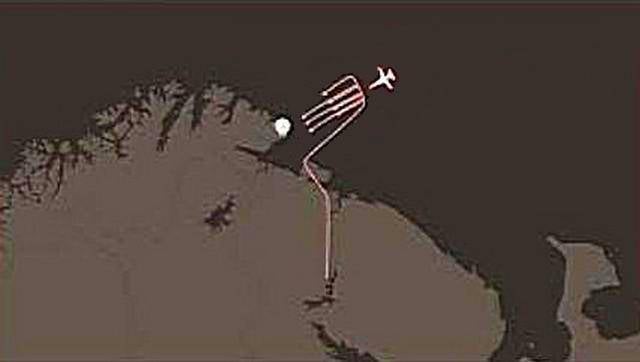
All of the above does not negate the need, as far as forces allow, to protect important objects, especially bases and airfields. You just need to have a fallback - always.
8. "Asymmetric" technical solutions and concepts
Very often, in response to the growth of a military threat to our country, such as, for example, the US missile defense system, our leaders have stated and are declaring that the answer will be inexpensive and “asymmetric”. “Asymmetry” has already become a kind of “brand”, today this word is inserted wherever you go, including in an openly thoughtless (and sometimes crazy) way.
The meaning of the idea itself is simple - you need to abandon the generally accepted canonical path of technology development, and make a breakthrough in the "non-standard" direction, one that will devalue the superiority of the enemy. Unlike the idea of a superweapon, here we are talking about the operation of an alternative concept of weapons, when instead of a super-powerful or ultra-efficient tool created using superior technology, a tool is created that is understandable to the enemy, and mainly based on the existing technological base, but there is one to counter which not ready.
In fact, the idea of creating an asymmetric low-cost tool is highly controversial. Not that it was not working, there are examples of working asymmetric concepts. It's just that it is far from always working and almost always expensive.
Let's look at some examples.
At the turn of the 20s and 30s, the Japanese managed to make an engineering breakthrough - to create an efficient large-caliber torpedo with a combined-cycle engine, in which oxygen was used as an oxidizing agent. It was precisely an engineering breakthrough - the Japanese did not invent anything new, but polished to the working state the existing “layer of technology”, which was universally recognized as a dead end. The result was a Type 93 torpedo or, as the Americans called it “Long Lance,” a long spear. The program of its creation "ate" a lot of resources, especially at the stage of arming ships. As a result, in theory, the Japanese were able to carry out massive torpedo volleys at the same range that only large-caliber guns could previously work on. Type 93 embarked on dozens of ships, on some he became the "main caliber." The range and speed of the torpedo, taking into account the power of its warhead, was unprecedented, and the combat use was successful.
Thus, there is an asymmetric method of warfare (an extra-long torpedo salvo instead of an artillery salvo at the same distance), and an attempt to create a superweapon is expensive and large-scale.
And even successfully destroyed ships, and a lot.
There’s only a problem: if we discard from statistics those goals that could be reached with ordinary torpedoes, and finishing off the type of an abandoned Hornet, then the feasibility of creating such weapons seems at least controversial. And if someone would undertake to analyze each episode of a successful “spear” strike and figure out whether it was possible to do with artillery, then in general the idea of an ultra-long-range torpedo starts to seem strange. Especially for the money.
The Soviet Union was also interested in asymmetric solutions. One example was the increase in the submarine speed of nuclear submarines. After experimenting with the super-expensive "Golden Fish" - K-222 submarine, the fastest submarine in history, the Navy has already received serial boats, in which speed was one of the main tactical properties, if not the main one. True, not missile, but torpedo boats (PLAT). We are talking about the 705 Lira project.
It was not for nothing that the Lira was called an underwater interceptor - the speed of the submarine allowed it to dodge even anti-submarine torpedoes, its maneuverability was also extraordinary. It took less than a minute to reach a power plant with an LMT reactor at full power — ten times faster than any “normal” submarine. Due to this, the "Lear" could simply hang on the tail of the U.S. Navy submarine, and when trying to attack the latter, it would be banal to get away from torpedoes. Of course, it was not as simple as it was written, but it was quite possible. At the same time, its high noise did not play a noticeable role - what is the use of observing a Russian submarine if it cannot be hit?
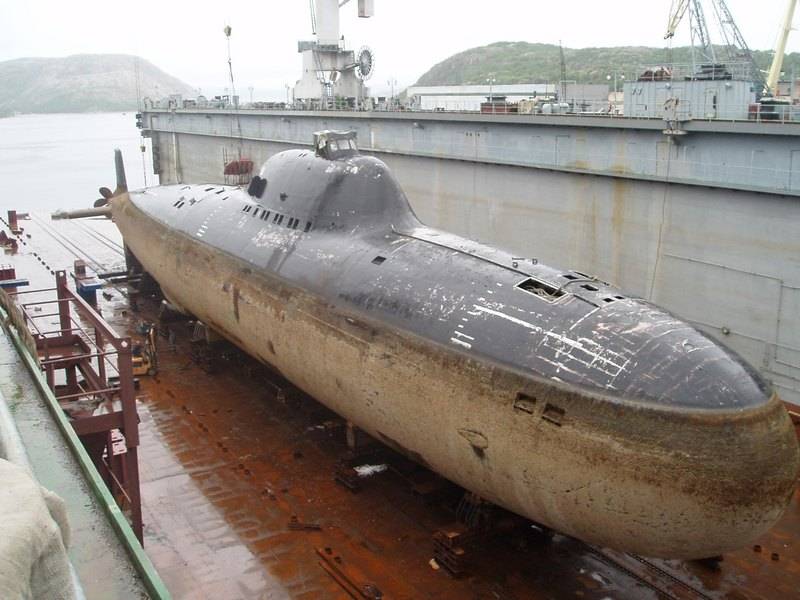
It was an “asymmetric” response to American superiority under water. And at first, he really seriously reduced this superiority. However, the Americans and the British eliminated this “asymmetric” advantage in an unpretentious direct way - by creating torpedoes that could “get” the “Lear”. As a result, its advantage evaporated, and all the shortcomings of the boat, which are widely known today, remained.
The expensive “asymmetric” solution was neutralized by another solution - symmetric and much cheaper.
However, there was one example where the "asymmetry" worked just "with a bang."
We are talking about naval missile-carrying aviation of the USSR Navy, and, if we look more broadly, then about long-range bombers armed with anti-ship missiles in principle.
The creation of MRA was the answer of the Soviet Union to the impossibility of creating several large ocean fleets in different parts of the country. Such aviation, firstly, in some cases negated the superiority of the West in the number of warships, secondly, it made it possible to very quickly inter-theater maneuver, thirdly, it was relatively universal - bombers could, if necessary, attack not only ships, and not just non-nuclear weapons. The instrument evolved slowly, but by the end of the 80's it was a force factor comparable to the American carrier-based aircraft and the carrier fleet - even if they did not have guaranteed superiority over them.
The “strike” that the MRA inflicted on the United States is significant. This is, firstly, the failed Phoenix missile and the F-14 interceptor concept, which was not particularly successful in its original form, which, with all its advantages, combined with the Phoenix and as an escort of deck-based drummers, was useless. In fact, the Americans created a plane whose full potential could only be revealed above the sea and only against MPA. Or it was necessary to equip it with conventional missiles and use it over land simply as a good interceptor, as the Iranians did, for example. But in this capacity, he was not worth his money.
MRA spawned the AEGIS system. Without constant risk of getting hit by a minimum of a regiment of bombers with cruise missiles, the US Navy would hardly have made such progress in air defense. But at the same time, this system cost the United States a lot of money, money that ended up being wasted - the war with the USSR did not happen, but the expenses went.
Also indirectly, it was the MPA that "killed" the Spryuens class destroyers. These ships could serve for a long time, but in order to maximize the effectiveness of naval air defense, the Americans had to replace them with Arly Burke class destroyers, and effective air defense was needed precisely against the Tupolevs. As a result, the Arly Burke program has grown to such a scale that it is now unclear whether the US Navy will ever have a new main warship (capital ship).
So far, the US military-industrial complex does not show the intellectual ability to come up with a “Burke” replacement, and perhaps this class of ships in America is “forever”, and without regard to whether America needs just such a ship or some other one is needed. This stagnation can cost the United States a lot in the long run. Andrei Nikolaevich Tupolev could be proud of what he had done.
One can only wonder how the Americans would use the money spent on countering MRA in another case. It is possible that we would not like it.
In order to finish with the description, let's say that, for example, one Tu-16 regiment could destroy all the forces of the British Navy, which were sent to the Falkland War in a few days. And there were many such regiments.
Thus, the “asymmetric” decision to replace the warship (which were not) with a heavy attack aircraft proved to be very effective.
But was it cheap? Dozens of regiments, consisting of the best in the world (in their class) planes, which were controlled by the best pilots in the world, with a huge raid, which were armed with the best cruise missiles in the world - this could not be cheap. And there wasn’t. The MRA was comparable in value to the carrier fleet, if you count not just the planes, but the full cost of this type of force, including training pilots, weapons, fuel, infrastructure. And, this tool had a lot of limitations.
So, an aircraft carrier could be sent to fight in the South Atlantic. Tu-16 - only if the base was provided on the theater of war and the possibility of flying to it. The issue of target designation for MRA was resolved in ways that in a real war could not but lead to heavy losses. For it, many airfields were needed, and, unlike tactical aviation, bombers could not disperse along public roads, and operation from the ground on a more or less regular basis looked extremely doubtful even for the Tu-16, and for the Tu-22М3 it was technically impossible.
MRA strikes needed to ensure complete surprise that in a real war it would not always be possible - either, would be accompanied by heavy losses. The combination of the need to conduct aerial reconnaissance and provide guidance for attack aircraft on their targets and the requirement to ensure surprise did not go very well together.
So this very effective “asymmetric” tool was also very expensive, and had a number of limitations in its combat use. Very serious limitations.
And yes, this is the only such successful example without quotes; there were no others like that.
What conclusions can be drawn from all this? “Asymmetric” solutions either do not work well, or not for long, and both in the case of a natural failure and in the case of unexpected success, they are very expensive. Especially successful, like MRA.
For a country with a weak economy and rich enemies, the "asymmetry" is likely to be unbearable. This does not mean that one should always give up on it, but one should approach this kind of innovation with extreme caution.
You should not expect that they will provide decisive superiority over the main opponent. The MRA, after all, did not provide one over the US Navy, although it did enable the Navy to defeat a substantial portion of the American forces in battle.
And do not understand all of the above, as a justification for abandoning the base attack aircraft of the Navy. We really need such aviation, which has already been said (see articles “We are building a fleet. The consequences of uncomfortable geography " и "On the need to recreate naval missile aircraft"), but her appearance is a topic for another discussion.
Conclusion
Erroneous ideas and incorrect concepts of naval construction in peacetime lead to wasteful spending of money in the war, to offensive and unjustifiable losses. At the same time, some of these ideas have their adherents both in the navy and in society. Some are already perceived as requiring no evidence. Meanwhile, “the well-known is not always true,” and in the case of the fleet this is more often so than not.
Russia is in a unique situation where it will have to intensify on the seas in conditions of extremely small resources and modest funding. In such circumstances, we can not afford any mistakes, not a single ruble spent in the wrong place.
And, of course, we cannot afford to “substitute” ourselves under the blow of a more powerful and much more experienced enemy in naval affairs.
Attempts to implement decisions that are based on erroneous ideas and incorrect concepts will lead precisely to embezzlement of money “not there” and to fall under attack.
When reconstructing the naval power of Russia, absolutely everything should be subjected to ruthless critical analysis.
We have no right to make a mistake, not even one.
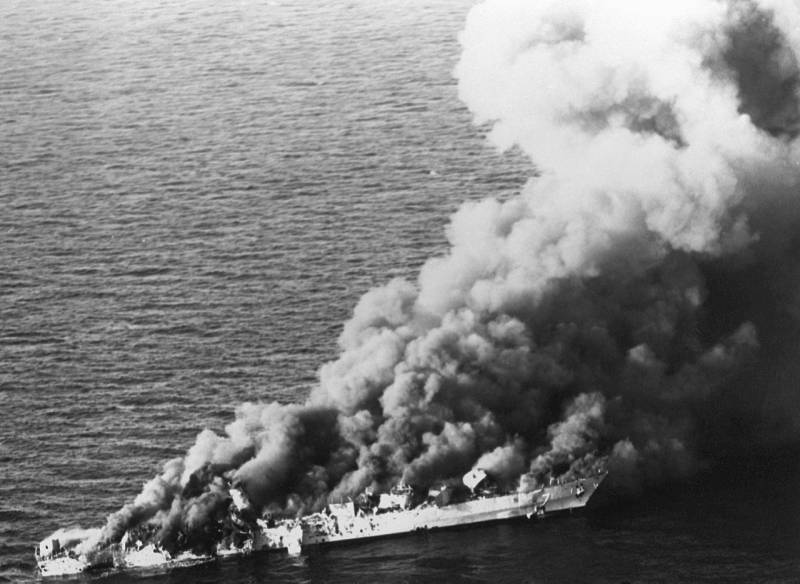
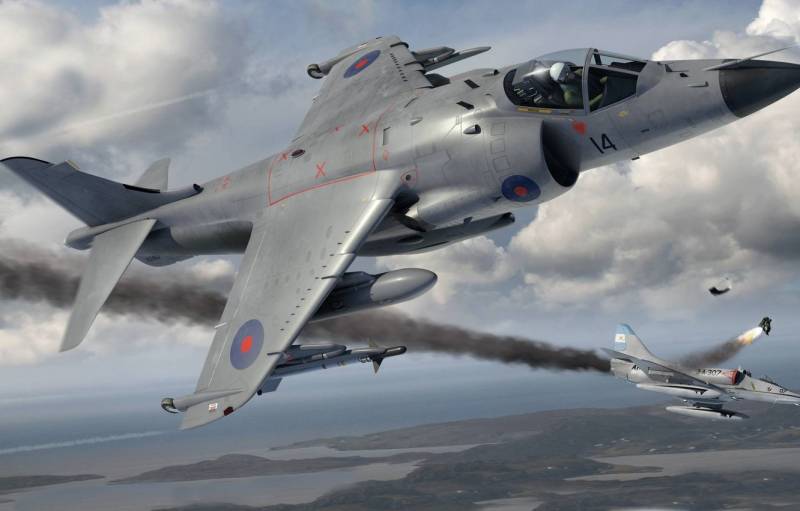
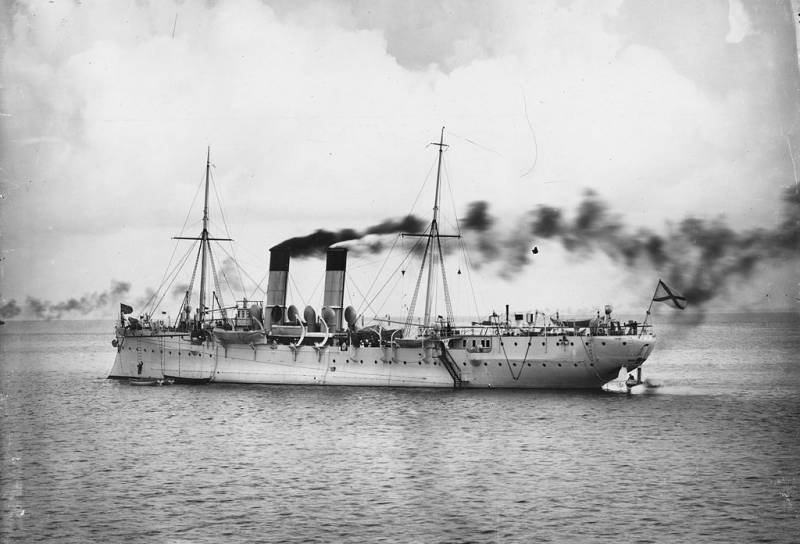

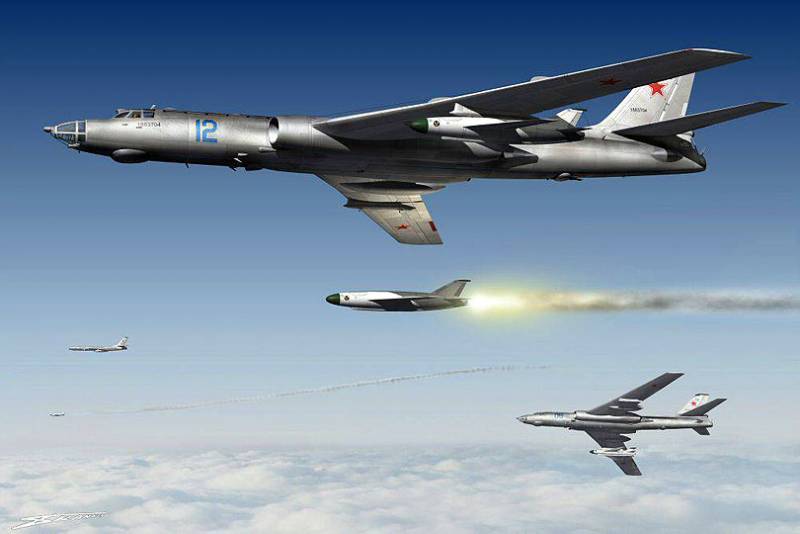
Information